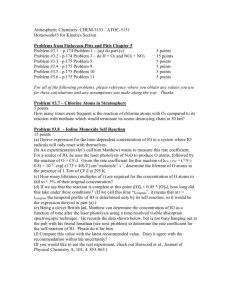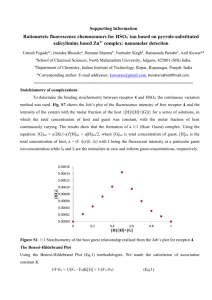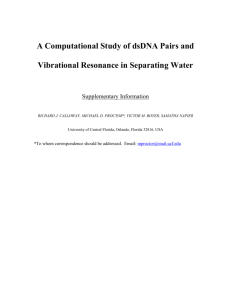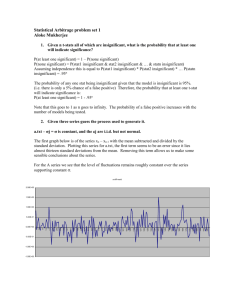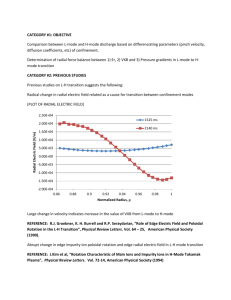Effects of Block Size on the Block Lanczos Algorithm
advertisement
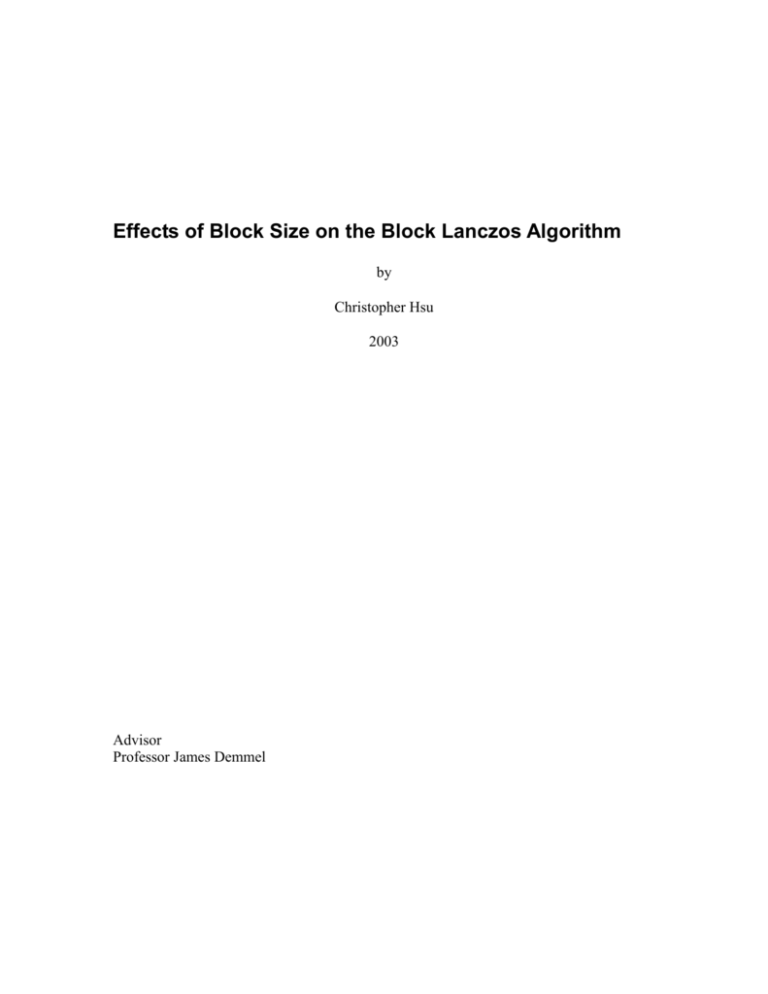
Effects of Block Size on the Block Lanczos Algorithm
by
Christopher Hsu
2003
Advisor
Professor James Demmel
Contents
1. Introduction
2. Single-Vector Lanczos Method
3. Block Lanczos Method
4. BLZPACK
5. Integrating SPARSITY Into BLZPACK
6. Nasasrb Matrix
7. Bcsstk, Crystk, and Vibrobox Matrices
8. Protein Matrices
9. Conclusion
10. Bibliography
Acknowledgements
First, I would like to thank Professor Demmel and Professor Yelick for supporting me as
a new member in a research group among members already familiar with the material I
had to spend weeks to learn. Their patience has allowed me to catch up and complete my
research for the semester. I would like to thank Professor Demmel especially for his
advice specific to my project, and for editing this report. I would also like to thank Rich
Vuduc for all his help in starting everything and with programming issues. I owe much
of my results to Benjamin Lee, who provided me with the information I needed to run all
my tests. I am grateful for the correspondence of Osni Marques, who provided
suggestions to point me in the right direction of obtaining the desired results. Finally, I
thank the BEBOP group members for all their support and insight.
1. Introduction
The problem of computing eigenvalues occurs in countless physical applications. For a
matrix A, an eigenvalue is a scalar such that for some nonzero vector x, Ax = x. The
vector x is called the corresponding eigenvector. We will refer to the eigenvalue and
eigenvector collectively as an eigenpair. The set of all eigenvalues is called the spectrum.
Such a problem is an example of a standard eigenvalue problem (SEP). In different
situations such as structural problems, we are given two matrices, a mass matrix M and a
stiffness matrix K. Then an eigenvalue is a scalar such that Kx = Mx. This type of
problem is known as a generalized eigenvalue problem (GEP). In my experiments I deal
with large, sparse real symmetric matrices. Real symmetric matrices have applications in
clustering analysis (power systems), physics (arrangements of atoms in a disordered
material), chemistry (calculation of bond energies in molecules), and much more. The
matrices I work with are of dimension ranging from 8070 to 54870.
For different eigenproblems, there are many possible algorithms to choose from when
deciding how to approach solving for eigenvalues. Templates for the Solution of
Algebraic Eigenvalue Problems [3] classifies eigenproblems by three characteristics.
The first is the mathematical properties of the matrix being examined. This includes
whether the matrix is Hermitian (or real symmetric), and whether it is a standard or
generalized problem. The second characteristic to consider is the desired spectral
properties of the problem. This includes the required accuracy of the eigenvalues,
whether we want the associated eigenvectors, and which and how many of the
eigenvalues from the spectrum of the matrix we desire. The third characteristic is the
available operations and their costs. Implementation of a specific algorithm may depend
on a particular data structure and the cost of operations on such a structure; restrictions on
how data is represented may restrict the options of available algorithms.
Depending on the properties of the problem we are solving, Templates [3] provides a
recommended algorithm to find eigenvalues. Classes of algorithms include direct
methods, Jacobi-Davidson methods, and Arnoldi methods. My research will examine a
particular variant of the Lanczos method, namely the block Lanczos method. BLZPACK
[8] (Block Lanczos Package) is a Fortran 77 implementation of the block Lanczos
algorithm, written by Osni Marques. My project consists of integrating BLZPACK with
SPARSITY [7], a toolkit that generates efficient matrix-vector multiplication routines for
matrices stored in a sparse format. I will give a description of SPARSITY as well as
BLZPACK and its interface in later sections. BLZPACK is capable of solving both the
standard and the generalized eigenvalue problems; however, my research focuses on the
standard problem.
The purpose of this project in particular is to examine the effects of changing the block
size (explained later) when applying the block Lanczos algorithm. My goal is to decrease
the overall execution time of the algorithm by increasing the block size. This involves
observing the time spent in different sections of the algorithm, as well as carefully
choosing optimal matrix subroutines. This work complements that of the BEBOP group
at Berkeley, whose interests include software performance tuning. In particular, BEBOP
explores SPARSITY performance in great detail. The relevance to BLZPACK lies in
matrix-vector multiplication unrolled across multiple vectors. Depending on the matrix,
the time spent for the operation A*[x1,...,xk] (i.e. a matrix A times k vectors) may be
much less than k times the time spent on Ax (i.e. a matrix A times a vector, done k
times). BLZPACK can be used with A*[ x1,...,xk] for any k (known as block size); my
work explores whether we can accelerate eigenvalue computation by using block size
greater than 1. The work performed by BLZPACK depends in a complicated fashion on
the matrix, block size, number of desired eigenvalues, and other parameters; hence the
answer to that question is not immediately obvious. As I will show, there are cases when
using a block size of 1 performs best, and also cases where a greater block size is better.
A related problem of using a blocked procedure for solving linear systems of equations
prompted the question of the usefulness of the analogous problem of computing
eigenvalues. GMRES [2] is a method for solving Ax = b, where A is large, sparse, and
non-symmetric. A blocked version LGMRES instead solves AX = B, incorporating fast
matrix-multivector-multiply routines. BLZPACK uses a similar approach involving
Krylov subspaces, which will be explained in greater detail in Section 2.
The first part of this report deals with the tools I work with: the Lanczos method (with a
description of the algorithm), BLZPACK, and SPARSITY. The second part is a
collection of the data gathered from my experiments and the results and conclusions
drawn from them.
2. Single-Vector Lanczos Method
The class of Lanczos methods refers to procedures for solving for eigenvalues by relying
on Lanczos recursion. Lanczos recursion (or tridiagonalization) was introduced by
Cornelius Lanczos in 1950. In this section I will describe the algorithm for the singlevector Lanczos method1.
The simplest Lanczos method uses single-vector Lanczos recursion. Given a real
symmetric (square) matrix A of dimension n and an initial unit vector v1 (usually
generated randomly), for j = 1,2,…,m the Lanczos matrices Tj are defined recursively as
follows:
Let z := Avi
i := viTz
z := z - ivi - i-1vi-1
i := ||z||2
vi+1 := z/i
The Lanczos matrix Tj is defined to be the real symmetric, tridiagonal matrix with
diagonal entries i for i = 1,2,...,j and subdiagonal and superdiagonal entries i for i =
1,2,...,j.
The vectors ivi and ivi-1 are the orthogonal projections of the vector Avi onto vi and vi-1
respectively. For each i, the Lanczos vector vi+1 is determined by orthogonalizing Avi
with respect to vi and vi-1. The Lanczos matrices are determined by the scalar coefficients
i and i+1 obtained in these orthogonalizations.
In all Lanczos methods, solving for an eigenvalue of a matrix A is simplified by replacing
A with one or more of the Lanczos matrices Tj’s. Real symmetric tridiagonal matrices
1
The details here are a summary of more complete explanations from Chapter 2 of Lanczos Algorithms for
Large Symmetric Eigenvalue Computations [4].
have small storage requirements and algorithms for their eigenpair computations are
efficient [4].
The basic Lanczos procedure follows these steps:
1. Given a real symmetric matrix A, construct (using Lanczos recursion) a family of
real symmetric tridiagonal matrices Tj for j = 1,2,...,M.
2. For some m M compute the relevant eigenvalues of the Lanczos matrix Tm.
(Relevance refers to which eigenvalues from the spectrum are desired, e.g. the
eigenvalue with highest absolute value.)
3. Select some or all of these eigenvalues as approximations to eigenvalues of the
given matrix A.
4. For each eigenvalue of A for which an eigenvector is required, compute a unit
eigenvector u such that Tmu = u. Map u into a vector y Vmu (where Vm is the
matrix whose kth column is the kth Lanczos vector), which is used as an
approximation to an eigenvector of A. Such a vector y is known as a Ritz vector;
eigenvalues of Lanczos matrices are called Ritz values of A.
In the Lanczos recursion formulas, the original matrix A is used only for the product Avi;
hence it is never modified. For large sparse matrices, this enables storage optimizations,
since a user only needs a subroutine which computes Ax for any vector x, which can be
done in space linear in the dimension of the matrix. Furthermore, the number of
arithmetic operations required to generate a Lanczos matrix is proportional to the number
of nonzero entries of A, as opposed to O(n3) (where n is the size of A) for procedures
which completely transform A into a real symmetric tridiagonal matrix by performing an
orthogonal similarity transformation.
That the Lanczos matrices possess eigenvalues that can reasonably approximate those of
A is not immediately clear. The key facts (which I state without proof2) are that the
Lanczos vectors form an orthonormal set of vectors, and that the eigenvalues of the
Lanczos matrices are the eigenvalues of A restricted to the family of subspaces Kj
2
The proof is in Chapter 2 of Lanczos Algorithms [4].
sp{v1,Av1,A2v1,...,Aj-1v1}, known as Krylov subspaces. If j is sufficiently large, the
eigenvalues of Tn should be good approximations to the eigenvalues of A. Continuing
the Lanczos recursion until j = n (where n is the size of A), Tn is an orthogonal similarity
transformation of A, and therefore has the same eigenvalues as A. A Ritz vector Vju
obtained from an eigenvector u of a given Tj is an approximation to a corresponding
eigenvector of A.
Error analysis is given in terms of the angle between a vector and a subspace, as
explained in Chapter 2 of Lanczos Algorithms [4]. It turns out that Krylov subspaces are
very good subspaces on which to compute eigenpair approximations. An important result
is that the error bound increases as we proceed into the spectrum; that is, extreme
eigenvalues and corresponding eigenvectors have higher expected accuracy than
eigenvalues in the interior of the spectrum. (Depending on the particular implementation,
however, this may not be the case.) For this reason the basic Lanczos method is often a
good algorithm to use when we desire a few extreme eigenvalues.
The above description of the Lanczos algorithm assumes exact arithmetic; in practice this
is usually not the case. Indeed, in computer implementations, finite precision causes
roundoff errors at every arithmetic operation. Computed quantities will obviously differ
from the theoretical values. When constructing the Lanczos matrices Tj, the Lanczos
vectors lose their orthogonality (and even linear independence) as j increases. The
Lanczos matrices are no longer orthogonal projections of A onto the subspaces sp{Vj}.
The theoretical relationship between Tj and A and error estimates are no longer
applicable. It was originally assumed that a total reorthogonalization of the Lanczos
vectors was required. There are Lanczos methods which in fact use no
reorthogonalization and employ modified recursion formulas. However, the variant I will
be working with uses selective orthogonalization and modified partial
reorthogonalization to preserve orthogonality of the Lanczos vectors, as will be described
later.
3. Block Lanczos Method
Many eigenvalue algorithms have variants in which blocks of vectors are used instead of
single vectors. When multiplying by vectors, these blocks can be considered matrices
themselves. As a result, instead of performing matrix-vector operations (Level 2 BLAS
routines [5]), matrix-matrix operations (Level 3 BLAS operations [5]) are used. This
allows for possible optimizations in the execution of the algorithm. I/O costs are
decreased by essentially a factor of the block size [1].
Lanczos methods in particular benefit from a blocked algorithm variant in another way.
Depending on the implementation, single-vector methods sometimes have difficulty
computing the multiplicities of eigenvalues, and for a multiple eigenvalue a complete
basis for the subspace may not be directly computed. A block Lanczos method may be
better for computing multiplicities and bases for invariant subspaces corresponding to
eigenvalues.
As an alternative to the recurrence relations for the single-vector variant, we use the
following approach3. Define matrices B1 0 and Q0 0. Let Q1 be an nxq matrix whose
columns are orthonormalized, randomly generated vectors, where n is the size of the
original matrix A and q is the block size. For i = 1,2,...,s define Lanczos blocks Qi
according to the following recursive equations:
Let Z := AQi
Ai := QiTZ
Z := Z – QiAi – Qi-1Bi-1
Factor Z = Qi+1Bi by Gram-Schmidt
The blocks Qj for j = 1,2,...,s form an orthonormal basis for the Krylov subspace
Ks(Q1,A) sp{Q1,AQ1,...,As-1Q1} corresponding to the first block. The Lanczos matrices
Ts are defined as the block tridiagonal matrices with A1,A2,...,As along the diagonal, and
B1,B2,...,Bs along the subdiagonal, and B1T,B2T,...,BsT along the superdiagonal.
3
The Block Lanczos algorithm described here is a summary of the steps described in Chapter 7 of Lanczos
Algorithms [4]. The proof of its correctness is there as well; I have not restated it here.
Analogously to the single-vector case, we approximate eigenvalues of A by computing
eigenvalues of the Ts matrices.
When A is large enough, the cost of this algorithm should be dominated by the
multiplication AQi, which is the operation for which we have specially tuned routines to
evaluate.
4. BLZPACK4
BLZPACK [8] (Block Lanczos Package) is a Fortran 77 implementation of the Block
Lanczos algorithm, written by Osni Marques. It is designed to solve both the standard
and generalized eigenvalue problems. I work with the standard problem, in which we
solve for eigenvalues and eigenvectors x that satisfy Ax = x, where A is a real sparse
symmetric matrix. There are single precision and a double precision versions; I use the
double precision version. The main subroutine is BLZDRD, to which the user passes
parameters and data I will describe in this section. The only computations involving A
are matrix-multiple-vector multiplications done outside the BLZDRD subroutine. In this
way, the representation for A and the implementation of matrix operations on A are
completely decided by the user.
The BLZDRD interface expects numerous arguments; here I will briefly run through the
parameters relevant to my project. Many parameters are ignored because they are
meaningless for the standard problem.
NI: The number of active rows of temporary arrays in the block Lanczos
algorithm on the current process. BLZPACK can be run in sequential or parallel
mode; for my project only the sequential mode is relevant, so NI is set to the
dimension of A.
LNI: Dimension of temporary arrays; LNI and NI have the same value in all my
experiments.
NREIG: The number of desired eigenpairs. I run my experiments with NREIG =
1, 10, and 50. The eigenvalues returned are those with the greatest magnitude.
LEIG: Dimension of the array in which to store converged eigenvalues (this may
be greater than NREIG). I used LEIG = (NREIG*2)+10.
NVBSET: The number of vectors in a block. This is the focus of the project; we
try to see when an increase in the block size leads to an increase in overall
performance. With a block size of 1, the algorithm essentially works as a singlevector Lanczos method. I run the algorithm with block sizes from 1 to 9.
4
The information in this section can be found in greater detail in the BLZPACK User’s Guide [9].
NSTART: Number of starting vectors given to BLZPACK; I use 0 for this value,
which causes BLZPACK to generate random starting vectors.
NGEIG: Number of eigenpairs given as input; 0 is used.
LISTOR/LRSTOR: Amount of workspace to allocate. For all experiments 107
was used for both values.
THRSH: The threshold for convergence. The default value ||A||√ε is used, where
ε is the machine precision 2.2204 x 10-16, and ||A|| is estimated by means of the
eigenvalue distribution computed by BLZPACK. A computed eigenpair (, x) is
considered converged iff ||Ax - x|| ≤ THRSH.
NSTEPS: The maximum number of steps to be performed per run. The default
value is used, which is determined by BLZPACK based on allocated workspace
(see LISTOR and LRSTOR). If not enough eigenpairs have converged after
NSTEPS, a restart is performed, using as initial vectors some linear combination
of the unconverged eigenvectors.
The block Lanczos algorithm is implemented as follows. Lanczos vectors are denoted by
Qj, and Qj is defined to be the basis of Lanczos vectors, [Q1 Q2 ... Qj]. Tj is the jth
Lanczos matrix (block tridiagonal) as described in the previous section. At initialization,
set Q0 = 0. Set R0 0 randomly and factorize R0 as Q1B1 where Q1TQ1 is the identity.
On the jth Lanczos step:
1. Compute Rj = AQj
2. Rj := Rj – Qj-1BjT
3. Aj := QjTRj
4. Rj := Rj - QjAj
5. Factorize Rj as Qj+1Bj+1 where Qj+1TQj+1 is the identity
6. If required, orthogonalize Qj and Qj+1 against the vectors in Qj-1
7. Insert Qj into Qj and Aj, Bj into Tj
8. Solve the reduced problem Tj
There are further steps to test convergence of the computed eigenpairs. If after some
number of steps (set either by the user or by default) not enough eigenpairs have
converged, Qj and Qj+1 are orthogonalized against specific previously computed vectors;
this is referred to as selective orthogonalization. The process is then restarted. The
orthogonalization in step 6 above is a modified partial orthogonalization. These two
orthogonalization strategies are employed as an alternative to total reorthogonalization
for preserving the orthogonality of the Lanczos vectors.
5. Integrating SPARSITY Into BLZPACK
SPARSITY5 [7] is a toolkit for generating optimized sparse matrix-vector multiplication
routines, developed by Eun-Jin Im and Katherine Yelick. SPARSITY employs register
blocking, which reorganizes the data structure representing the matrix by identifying
small blocks of nonzero elements and storing these blocks contiguously. Further
optimization is made possible generating code that unrolls across multiple vectors, so that
the operation becomes more similar to a matrix-matrix multiplication, where one matrix
is sparse and the other is dense. The result of unrolling is often a speedup significant
enough that the time for (A * k vectors) is much lower than k times the time for (A * a
single vector). SPARSITY examines a given matrix, and depending on the architecture,
generates a suitable routine. Ongoing research examines the effects of taking into
account symmetry when generating code. For the purposes of my project, I will refer to a
particular SPARSITY-generated routine as a “rxcxv (symmetric or non-symmetric)
implementation”, where rxc is the block size by which the matrix is blocked, and v is the
number of right-hand-sides (vectors) to unroll across. This project was completed on an
UltraSPARC processor with a clock rate of 333 MHz, using f77 to compile BLZPACK
and cc to compile the BLZPACK driver as well as SPARSITY-generated routines.
To use BLZPACK, I wrote a driver in C which calls the BLZDRD routine, and between
calls computes V := A*U using a SPARSITY-generated routine. The particular routine is
determined beforehand according to the matrix A and the block size of the block Lanczos
algorithm. Optimal implementations given the number of right-hand-sides were provided
to me by Rich Vuduc and Benjamin Lee. For the matrices, I ran the block Lanczos
algorithm with NREIG = 1, 10, and 50, and with NVBSET = 1 to 9. The goal was to find
an example where a block size of greater than 1 gave a better performance than using a
block size of 1 (which is the single-vector algorithm). To see any improved performance,
the speedup from using a multiple-vector matrix-vector-multiply routine over a singlevector routine must at least outweigh the increase in the number of matrix-vector
operations required by the algorithm. Furthermore, that speedup should also dominate
5
The information on SPARSITY was taken from Eun-Jin’s Ph.D. thesis [5].
increases in other operations required by the block Lanczos algorithm, such as vector
generation and reorthogonalization.
The remainder of this report deals with the data given by BLZPACK, and the results
drawn from it.
6. Nasasrb Matrix
Nasasrb [6] is the matrix on which I performed the most extensive tests. It has dimension
54870, with 2677324 nonzeros, a density of 0.09%. It is used in shuttle rocket booster
applications. I ran it through BLZPACK with 1, 10, and 50 required eigenpairs, with
block sizes ranging from NVBSET = 1 to 9. The results are shown in Figures 6.1-6.3
below. The matrix-vector-multiply implementations (see the previous section on
SPARSITY for an explanation about my notation) for particular right-hand-sides are as
follows:
1 RHS: 3x3x1 symmetric
2 RHS: 3x2x2 symmetric
3 RHS: 2x1x3 symmetric
4 RHS: 2x1x4 symmetric
5 RHS: 3x2x5 non-symmetric
6 RHS: 3x2x6 non-symmetric
7 RHS: 2x3x7 non-symmetric
8 RHS: 2x1x8 non-symmetric
9 RHS: 2x1x9 non-symmetric
From the results, we can see that increasing the block size from 1 does reduce the time
spent doing matrix-vector operations (specifically, the A*U operation between calls to
BLZDRD), at least up to block size 4 before increasing again. Even with the increase in
the number of matrix-vector operations required to satisfy BLZPACK’s stopping
criterion based on convergence (see column labeled “# MVM Ops”), the speedup in the
implementation (see column labeled “Time per MVM”) is enough to decrease the total
time spent doing matrix-vector multiplies (see column labeled “Time for MVM Ops”).
However, we can see that for all numbers of required eigenpairs, the total execution time
(see column labeled “Total Time”) is always lowest with the single-vector case (block
size 1). Therefore, the single-vector procedure is the most time-efficient algorithm to
use. Note that overall time is not necessarily an increasing function of block size. For 1
and 10 required eigenpairs, the overall time with block size 4 is actually lower than with
block size 3. Nevertheless, it is still fastest with block size 1 in both cases.
The percentage of time spent in A*U operations is about 30-40% for small block sizes, to
10% or less for higher block sizes (see column “% Time Spent for MVM”). Examining
the data more closely reveals that the bottleneck is specifically in the reorthogonalization
(see column “Time for Reorth”). Therefore, any speedup gained by increasing block size
is dominated by the increase in reorthogonalization costs, thus accounting for the increase
in overall time. Note that there is a speedup in the time it takes per matrix-vector
multiply as we increase block size (see column “Time per MVM”); this is what we
expect from SPARSITY, that multiplying multiple vectors is faster (per vector) than
multiplying a single vector. Still, it is not enough to outweigh other costs. Aside from
matrix-vector operations and reorthogonalization, BLZPACK spends its time in vector
generation, solving the reduced problem, and computing Ritz vectors.
Consulting with Osni Marques offered two insights on possible situations where using a
block size greater than 1 might be advantageous. First, the subroutines used to perform
reorthogonalizations change when moving from 1 to multiple vectors. With a single
vector, BLAS-2 operations are used. Using a bigger block size employs BLAS-3
operations instead. It is possible that continuing to use BLAS-2 operations on multiple
vectors may change the performance. However, Osni commented that while this may
work for small matrices, it would almost surely not work for large ones. The second idea
was that while for this particular matrix (nasasrb) the single-vector procedure worked
best, there may be matrices for which the A*U operations dominate the
reorthogonalizations. (Indeed, I will show later an example of matrices where this is the
case.) Then in those cases, a block implementation would improve performance.
In the next sections, I discuss the results of running the same tests on different matrices.
However, I chose to show results for block size up to 5 since anything higher generally
did not help; in fact, calculating megaflop rates indicate that the matrix-vector-multiply
routines generated by SPARSITY usually show decreased performance with right-handsides greater than 5 or 6.
Figure 6.1 nasasrb – 1 required eigenpair
#
#
Vectors MVM Time for
in Block Ops MVM Ops
1
84 6.40E+00
2 110 5.04E+00
3 120 5.07E+00
4 132 4.59E+00
5 150 5.97E+00
6 168 5.88E+00
7 182 6.79E+00
8 184 6.12E+00
9 234 8.49E+00
Time per
MVM
7.62E-02
4.58E-02
4.23E-02
3.48E-02
3.98E-02
3.50E-02
3.73E-02
3.33E-02
3.63E-02
% Time % Time % Time
Time for
Spent for Spent Spent
Reorth
Total Time MVM
Reorth Other
5.38E+00 1.44E+01
44%
37%
18%
9.59E+00 2.17E+01
23%
44%
33%
1.34E+01 2.45E+01
21%
55%
25%
1.19E+01 2.36E+01
19%
50%
30%
1.61E+01 3.16E+01
19%
51%
30%
2.14E+01 4.14E+01
14%
52%
34%
2.28E+01 4.95E+01
14%
46%
40%
2.53E+01 5.33E+01
11%
47%
41%
2.99E+01 6.80E+01
12%
44%
44%
1 Eigenpair, MVM Time
9.00E+00
8.00E+00
Seconds
7.00E+00
6.00E+00
5.00E+00
4.00E+00
3.00E+00
2.00E+00
1.00E+00
0.00E+00
0
2
4
6
8
10
6
8
10
Block Size
1 Eigenpair, Total Time
8.00E+01
7.00E+01
Seconds
6.00E+01
5.00E+01
4.00E+01
3.00E+01
2.00E+01
1.00E+01
0.00E+00
0
2
4
Block Size
Figure 6.2 nasasrb – 10 required eigenpairs
#
#
% Time
% Time % Time
Vectors MVM Time for
Time per Time for
Spent for Spent
Spent
in Block Ops MVM Ops MVM
Reorth
Total Time MVM
Reorth
Other
1
90 6.84E+00 7.60E-02 6.23E+00 1.62E+01
42%
38%
19%
2
110 5.04E+00 4.58E-02 1.16E+01 2.17E+01
23%
53%
23%
3
135 5.68E+00 4.21E-02 1.65E+01 2.97E+01
19%
56%
25%
4
148 5.14E+00 3.47E-02 1.49E+01 2.86E+01
18%
52%
30%
5
170 6.75E+00 3.97E-02 2.07E+01 4.09E+01
17%
51%
33%
6
180 6.31E+00 3.51E-02 2.17E+01 4.50E+01
14%
48%
38%
7
182 6.81E+00 3.74E-02 2.29E+01 4.94E+01
14%
46%
40%
8
232 7.69E+00 3.31E-02 3.07E+01 6.84E+01
11%
45%
44%
9
270 9.83E+00 3.64E-02 3.44E+01 7.79E+01
13%
44%
43%
10 Eigenpairs, MVM Time
1.20E+01
1.00E+01
Seconds
8.00E+00
6.00E+00
4.00E+00
2.00E+00
0.00E+00
0
2
4
6
8
10
8
10
Block Size
10 Eigenpairs, Total Tim e
9.00E+01
8.00E+01
7.00E+01
Seconds
6.00E+01
5.00E+01
4.00E+01
3.00E+01
2.00E+01
1.00E+01
0.00E+00
0
2
4
6
Block Size
Figure 6.3 nasasrb – 50 required eigenpairs
#
#
Vectors MVM Time for
Time per
Time for
in Block Ops MVM Ops MVM
Reorth
1
151 1.14E+01 7.55E-02 1.90E+01
2
170 7.80E+00 4.59E-02 2.96E+01
3
201 8.46E+00 4.21E-02 1.09E+01
4
344 1.19E+01 3.46E-02 4.98E+01
5
390 1.54E+01 3.95E-02 6.13E+01
6
612 2.14E+01 3.50E-02 1.05E+02
7
651 2.44E+01 3.75E-02 1.16E+02
8
848 2.82E+01 3.33E-02 1.64E+02
9
882 3.21E+01 3.64E-02 1.77E+02
Total Time
3.73E+01
4.78E+01
5.64E+01
8.79E+01
1.15E+02
1.90E+02
2.21E+02
3.08E+02
3.39E+02
% Time % Time % Time
Spent for Spent
Spent
MVM
Reorth
Other
31%
51%
18%
16%
62%
22%
15%
55%
30%
14%
57%
30%
13%
53%
33%
11%
55%
33%
11%
52%
36%
9%
53%
38%
9%
52%
38%
50 Eigenpairs, MVM Tim e
3.50E+01
3.00E+01
Seconds
2.50E+01
2.00E+01
1.50E+01
1.00E+01
5.00E+00
0.00E+00
0
2
4
6
8
10
8
10
Block Size
50 Eigenpairs, Total Tim e
4.00E+02
3.50E+02
Seconds
3.00E+02
2.50E+02
2.00E+02
1.50E+02
1.00E+02
5.00E+01
0.00E+00
0
2
4
6
Block Size
7. Bcsstk, Crystk, and Vibrobox Matrices
The bcsstk [6] matrix, used in an automobile frame application, has dimension 30237 and
1450163 nonzeros, a density of 0.16%. As before, the single-vector procedure is optimal
for all numbers of required eigenvalues, even though execution time does not necessarily
increase with block size. The matrix-vector-multiply implementations used are as
follows:
1 RHS: 3x3x1 symmetric
2 RHS: 3x2x2 symmetric
3 RHS: 3x1x3 symmetric
4 RHS: 2x1x4 symmetric
5 RHS: 3x2x5 non-symmetric
The crystk [6] matrix is used for crystal free vibration applications. It has dimension
24696 and 1751178 nonzeros, a density of 0.29%. The single-vector procedure is
optimal. The matrix-vector-multiply implementations are:
1 RHS: 3x3x1 symmetric
2 RHS: 3x2x2 symmetric
3 RHS: 3x1x3 symmetric
4 RHS: 2x1x4 symmetric
5 RHS: 3x1x5 non-symmetric
The vibrobox [6] matrix is used for the structure of the vibroacoustic problem. It has
dimension 12328 with 34828 nonzeros, a density of 0.23%. Once again, the singlevector procedure is optimal. Blocking of this matrix was not helpful in optimizing
matrix-vector-multiply routines, so the 1x1xv (with v equal to the block size for the
Lanczos algorithm) routine, using the symmetric version for block sizes 1 to 4 and nonsymmetric for block size 5.
Figure 7.1 bcsstk – 1 required eigenpair
#
#
Vectors MVM Time for
in Block Ops
MVM Ops
1
16
6.24E-01
2
28
7.17E-01
3
36
7.89E-01
4
44
7.99E-01
5
55 1.16E+00
Time per
MVM
3.90E-02
2.56E-02
2.19E-02
1.82E-02
2.11E-02
Time for
%
%
%
Reorth
Total Time MVM Reorth Other
1.59E-01 1.30E+00 48%
12%
40%
6.51E-01 2.22E+00 32%
29%
38%
1.13E+00 3.10E+00 25%
36%
38%
1.23E+00 3.52E+00 23%
35%
42%
1.94E+00 5.08E+00 23%
38%
39%
1 Eigenpair, MVM Time
1.40E+00
1.20E+00
Seconds
1.00E+00
8.00E-01
6.00E-01
4.00E-01
2.00E-01
0.00E+00
0
1
2
3
4
5
6
4
5
6
Block Size
1 Eigenpair, Total Time
6.00E+00
5.00E+00
Seconds
4.00E+00
3.00E+00
2.00E+00
1.00E+00
0.00E+00
0
1
2
3
Block Size
Figure 7.2 bcsstk – 10 required eigenpairs
Time for
%
%
%
Reorth
Total Time MVM Reorth Other
1.34E+00 4.06E+00 44%
33%
23%
2.69E+00 5.69E+00 27%
47%
26%
3.86E+00 7.53E+00 21%
51%
28%
3.30E+00 7.28E+00 20%
45%
35%
5.18E+00 1.08E+01 20%
48%
32%
10 Eigenpairs, MVM Time
2.50E+00
2.00E+00
Seconds
1
2
3
4
5
#
MVM Time for
Time per
Ops
MVM Ops MVM
45 1.79E+00 3.98E-02
58 1.51E+00 2.60E-02
72 1.57E+00 2.18E-02
80 1.45E+00 1.81E-02
100 2.12E+00 2.12E-02
1.50E+00
1.00E+00
5.00E-01
0.00E+00
0
1
2
3
4
5
6
4
5
6
Block Size
10 Eigenpairs, Total Time
1.20E+01
1.00E+01
8.00E+00
Seconds
#
Vectors
in Block
6.00E+00
4.00E+00
2.00E+00
0.00E+00
0
1
2
3
Block Size
Figure 7.3 bcsstk – 50 required eigenpairs
#
#
Vectors MVM Time for
Time per Time for
%
%
%
in Block Ops
MVM Ops MVM
Reorth
Total Time MVM Reorth Other
1
150 5.99E+00 3.99E-02 1.68E+01 2.66E+01 23%
63%
14%
2
172 4.45E+00 2.59E-02 2.17E+01 3.16E+01 14%
69%
17%
3
324 7.12E+00 2.20E-02 3.87E+01 5.68E+01 13%
68%
19%
4
356 6.41E+00 1.80E-02 3.12E+01 5.02E+01 13%
62%
25%
5
420 8.86E+00 2.11E-02 3.69E+01 6.23E+01 14%
59%
27%
50 Eigenpairs, MVM Time
1.00E+01
9.00E+00
8.00E+00
Seconds
7.00E+00
6.00E+00
5.00E+00
4.00E+00
3.00E+00
2.00E+00
1.00E+00
0.00E+00
0
1
2
3
4
5
6
4
5
6
Block Size
50 Eigenpairs, Total Time
7.00E+01
6.00E+01
Seconds
5.00E+01
4.00E+01
3.00E+01
2.00E+01
1.00E+01
0.00E+00
0
1
2
3
Block Size
Figure 7.4 crystk – 1 required eigenpair
#
Vectors #
Time for
in
MVM MVM
Time per Time for
%
%
%
Block
Ops Ops
MVM
Reorth
Total Time MVM Reorth Other
1
45 2.00E+00 4.44E-02 5.79E-01 3.27E+00 61%
18%
21%
2
96 2.71E+00 2.82E-02 2.97E+00 7.31E+00 37%
41%
22%
3
99 2.41E+00 2.43E-02 3.26E+00 7.63E+00 32%
43%
26%
4
108 2.41E+00 2.23E-02 2.66E+00 7.30E+00 33%
36%
31%
5
130 3.07E+00 2.36E-02 4.07E+00 1.03E+01 30%
40%
31%
1 Eigenpair, MVM Time
3.50E+00
3.00E+00
Seconds
2.50E+00
2.00E+00
1.50E+00
1.00E+00
5.00E-01
0.00E+00
0
1
2
3
4
5
6
4
5
6
Block Size
1 Eigenpair, Total Time
1.20E+01
1.00E+01
Seconds
8.00E+00
6.00E+00
4.00E+00
2.00E+00
0.00E+00
0
1
2
3
Block Size
Figure 7.5 crystk – 10 required eigenpairs
#
Vectors #
Time for
in
MVM MVM
Time per Time for
%
%
%
Block
Ops Ops
MVM
Reorth
Total Time MVM Reorth Other
1
94 4.18E+00 4.45E-02 2.36E+00 7.86E+00 53%
30%
17%
2
132 3.74E+00 2.83E-02 5.33E+00 1.15E+01 33%
46%
21%
3
171 4.15E+00 2.43E-02 8.48E+00 1.64E+01 25%
52%
23%
4
156 3.52E+00 2.26E-02 4.91E+00 1.20E+01 29%
41%
30%
5
220 5.22E+00 2.37E-02 7.44E+00 1.85E+01 28%
40%
32%
10 Eigenpairs, MVM Time
6.00E+00
5.00E+00
Seconds
4.00E+00
3.00E+00
2.00E+00
1.00E+00
0.00E+00
0
1
2
3
4
5
6
4
5
6
Block Size
10 Eigenpairs, Total Time
2.00E+01
1.80E+01
1.60E+01
Seconds
1.40E+01
1.20E+01
1.00E+01
8.00E+00
6.00E+00
4.00E+00
2.00E+00
0.00E+00
0
1
2
3
Bock Size
Figure 7.6 crystk – 50 required eigenpairs
#
#
Vectors MVM Time for
Time per Time for
%
%
%
in Block Ops MVM Ops MVM
Reorth
Total Time MVM Reorth Other
1
301 1.35E+01 4.49E-02 2.13E+01 4.02E+01
34%
53%
13%
2
714 2.04E+01 2.86E-02 6.93E+01 1.04E+02
20%
67%
14%
3 1383 3.37E+01 2.44E-02 1.33E+02 1.98E+02
17%
67%
16%
4 1192 2.67E+01 2.24E-02 9.65E+01 1.51E+02
18%
64%
18%
5 1260 2.97E+01 2.36E-02 1.03E+02 1.67E+02
18%
62%
21%
50 Eigenpairs, MVM Time
4.00E+01
3.50E+01
Seconds
3.00E+01
2.50E+01
2.00E+01
1.50E+01
1.00E+01
5.00E+00
0.00E+00
0
1
2
3
4
5
6
4
5
6
Block Size
50 Eigenpairs, Total Time
2.50E+02
Seconds
2.00E+02
1.50E+02
1.00E+02
5.00E+01
0.00E+00
0
1
2
3
Block Size
Figure 7.7 vibrobox – 1 required eigenpair
#
#
Vectors MVM Time for
Time per Time for
%
%
%
in Block Ops
MVM Ops MVM
Reorth
Total Time MVM Reorth Other
1
53 8.76E-01 1.65E-02 3.58E-01 1.62E+00 54%
22% 24%
2
108 1.07E+00 9.91E-03 1.65E+00 3.70E+00 29%
45% 26%
3
153 1.29E+00 8.43E-03 3.31E+00 6.41E+00 20%
52% 28%
4
156 1.13E+00 7.24E-03 2.18E+00 5.27E+00 21%
41% 37%
5
240 1.94E+00 8.08E-03 3.96E+00 9.21E+00 21%
43% 36%
1 Eigenpair, MVM Time
2.50E+00
Seconds
2.00E+00
1.50E+00
1.00E+00
5.00E-01
0.00E+00
0
1
2
3
4
5
6
4
5
6
Block Size
1 Eigenpair, Total Time
1.00E+01
9.00E+00
8.00E+00
Seconds
7.00E+00
6.00E+00
5.00E+00
4.00E+00
3.00E+00
2.00E+00
1.00E+00
0.00E+00
0
1
2
3
Block Size
Figure 7.8 vibrobox – 10 required eigenpairs
#
#
Vectors MVM Time for
in Block Ops MVM Ops
1
123 2.13E+00
2
156 1.66E+00
3
180 1.55E+00
4
260 1.95E+00
5
300 2.37E+00
Time per
MVM
1.73E-02
1.06E-02
8.61E-03
7.50E-03
7.90E-03
Time for
Reorth
1.83E+00
3.33E+00
4.10E+00
3.60E+00
4.93E+00
%
%
%
Total Time MVM Reorth Other
4.92E+00
43%
37%
20%
6.74E+00
25%
49%
26%
8.04E+00
19%
51%
30%
8.90E+00
22%
40%
38%
1.14E+01
21%
43%
36%
10 Eigenpairs, MVM Time
2.50E+00
Seconds
2.00E+00
1.50E+00
1.00E+00
5.00E-01
0.00E+00
0
1
2
3
4
5
6
4
5
6
Block Size
10 Eigenpairs, Total Time
1.20E+01
1.00E+01
Seconds
8.00E+00
6.00E+00
4.00E+00
2.00E+00
0.00E+00
0
1
2
3
Block Size
Figure 7.9 vibrobox – 50 required eigenpairs
#
Vectors
in Block
1
2
3
4
5
#
MVM
Ops
336
900
2094
1748
2410
Time for
MVM Ops
5.64E+00
9.86E+00
1.90E+01
1.43E+01
1.87E+01
Time per
MVM
1.68E-02
1.10E-02
9.07E-03
8.18E-03
7.76E-03
Time for
%
%
%
Reorth
Total Time MVM Reorth Other
7.68E+00 1.66E+01
34%
46%
20%
2.44E+01 4.45E+01
22%
55%
23%
6.30E+01 1.09E+02
17%
58%
25%
3.67E+01 7.47E+01
19%
49%
32%
5.78E+01 1.14E+02
16%
51%
33%
50 Eigenpairs, MVM Time
2.00E+01
1.80E+01
1.60E+01
Seconds
1.40E+01
1.20E+01
1.00E+01
8.00E+00
6.00E+00
4.00E+00
2.00E+00
0.00E+00
0
1
2
3
4
5
6
4
5
6
Block Size
50 Eigenpairs, Total Time
1.20E+02
1.00E+02
Seconds
8.00E+01
6.00E+01
4.00E+01
2.00E+01
0.00E+00
0
1
2
3
Block Size
8. Protein Matrices
The tests run on the previous matrices were repeated on two more, both used in protein
applications. The smaller one, pdb1FXK, has dimension 8070 and 1088905 nonzeros, a
density of 1.67%. The larger of the two protein matrices, pdb1TUP, gave more
interesting results. It has dimension 16323 and 2028247 nonzeros, a density of 7.61%.
Blocking these matrices did not help, so the 1x1xv implementation was used for v
=1,...,5, all with the symmetric version.
As indicated by Figures 8.1-8.3, for the FXK protein matrix, the single-vector procedure
was optimal. From Figures 8.4 and 8.5, we can see that this is the case for the TUP
matrix as well, when we require 1 or 10 eigenpairs. However, Figure 8.6 shows that
when we require 50 eigenpairs, using a block size of 2, 3, 4, or 5 performs better than the
single-vector procedure, with 2 being the optimal.
Note that for both matrices, the time spent performing A*U operations is around 80-90%
of the total execution time for a block size of 1, and around 50-60% for higher block
sizes. In contrast to previous matrices, the algorithm is always spending more than half
the total time on A*U operations. In particular, reorthogonalization costs no longer
dominate matrix-vector operation costs. In accordance with Osni Marques’ suggestion
mentioned earlier, we begin to see improved performance with increased block size when
matrix-vector operations dominate the algorithm.
Figure 8.1 pdb1FXK – 1 required eigenpair
#
#
Vectors MVM Time for
in Block Ops MVM Ops
1
82 8.12E+00
2
144 8.37E+00
3
180 8.16E+00
4
220 7.42E+00
5
320 1.04E+01
Time per
MVM
9.90E-02
5.81E-02
4.53E-02
3.37E-02
3.25E-02
Time for
%
%
%
Reorth
Total Time MVM Reorth Other
4.70E-01 8.98E+00 90%
5%
4%
1.61E+00 1.11E+01 75%
15%
10%
2.14E+00 1.22E+01 67%
19%
14%
1.70E+00 1.12E+01 66%
15%
19%
2.61E+00 1.61E+01 65%
16%
19%
1 Eigenpair, MVM Time
1.20E+01
1.00E+01
Seconds
8.00E+00
6.00E+00
4.00E+00
2.00E+00
0.00E+00
0
1
2
3
4
5
6
4
5
6
Block Size
1 Eigenpair, Total Time
1.80E+01
1.60E+01
1.40E+01
Seconds
1.20E+01
1.00E+01
8.00E+00
6.00E+00
4.00E+00
2.00E+00
0.00E+00
0
1
2
3
Block Size
Figure 8.2 pdb1FXK – 10 required eigenpairs
#
#
Vectors MVM Time for
Time per Time for
%
%
%
in Block Ops MVM Ops MVM
Reorth
Total Time MVM Reorth
Other
1 162 1.60E+01 9.88E-02
1.81E+00 1.89E+01
85%
10%
6%
2 442 2.56E+01 5.79E-02
4.00E+00 3.47E+01
74%
16%
11%
3 609 2.73E+01 4.48E-02
8.92E+00 4.21E+01
65%
21%
14%
4 684 2.30E+01 3.36E-02
6.54E+00 3.61E+01
64%
18%
18%
5 675 2.27E+01 3.36E-02
6.90E+00 3.66E+01
62%
19%
19%
10 Eigenpairs, MVM Time
3.00E+01
2.50E+01
Seconds
2.00E+01
1.50E+01
1.00E+01
5.00E+00
0.00E+00
0
1
2
3
4
5
6
4
5
6
Block Size
10 Eigenpairs, Total Time
4.50E+01
4.00E+01
3.50E+01
Seconds
3.00E+01
2.50E+01
2.00E+01
1.50E+01
1.00E+01
5.00E+00
0.00E+00
0
1
2
3
Block Size
Figure 8.3 pdb1FXK – 50 required eigenpairs
#
#
Vectors MVM Time for
Time per Time for
%
%
%
in Block Ops
MVM Ops MVM
Reorth
Total Time MVM Reorth Other
1 1468 1.45E+02 9.88E-02 2.91E+01 1.85E+02
78%
16%
6%
2 2340 1.36E+02 5.81E-02 3.95E+01 1.96E+02
69%
20%
10%
3 2880 1.30E+02 4.51E-02 5.87E+01 2.18E+02
60%
27%
13%
4 3396 1.15E+02 3.39E-02 5.84E+01 2.07E+02
56%
28%
16%
5 4335 1.46E+02 3.37E-02 7.40E+01 2.67E+02
55%
28%
18%
50 Eigenpairs, MVM Time
1.60E+02
1.40E+02
Seconds
1.20E+02
1.00E+02
8.00E+01
6.00E+01
4.00E+01
2.00E+01
0.00E+00
0
1
2
3
4
5
6
4
5
6
Block Size
50 Eigenpairs, Total Time
3.00E+02
2.50E+02
Seconds
2.00E+02
1.50E+02
1.00E+02
5.00E+01
0.00E+00
0
1
2
3
Block Size
Figure 8.4 pdb1TUP – 1 required eigenpair
#
#
Vectors MVM Time for
Time per
in Block Ops
MVM Ops MVM
1
54 1.03E+01 1.91E-01
2
88 1.03E+01 1.17E-01
3
132 1.22E+01 9.24E-02
4
156 1.04E+01 6.67E-02
5
180 1.13E+01 6.28E-02
Time for
%
%
%
Reorth
Total Time MVM Reorth Other
4.92E-01 1.14E+01
90%
4%
5%
1.55E+00 1.29E+01
80%
12%
8%
3.09E+00 1.73E+01
71%
18%
12%
2.97E+00 1.58E+01
66%
19%
15%
3.72E+00 1.83E+01
62%
20%
18%
1 Eigenpair, MVM Time
1.25E+01
Seconds
1.20E+01
1.15E+01
1.10E+01
1.05E+01
1.00E+01
0
1
2
3
4
5
6
4
5
6
Block Size
1 Eigenpair, Total Time
2.00E+01
1.80E+01
1.60E+01
Seconds
1.40E+01
1.20E+01
1.00E+01
8.00E+00
6.00E+00
4.00E+00
2.00E+00
0.00E+00
0
1
2
3
Block Size
Figure 8.5 pdb1TUP – 10 required eigenpairs
#
#
Vectors MVM Time for
Time per
Time for
%
%
%
in Block Ops
MVM Ops MVM
Reorth
Total Time MVM Reorth Other
1
152 2.91E+01
1.91E-01 3.74E+00
3.45E+01 84%
11%
5%
2
242 2.80E+01
1.16E-01 6.13E+00
3.76E+01 74%
16%
9%
3
486 4.56E+01
9.38E-02 1.49E+00
6.83E+01 67%
22%
11%
4
528 3.52E+01
6.67E-02 1.25E+00
5.66E+01 62%
22%
16%
5
670 4.24E+01
6.33E-02 1.66E+00
7.15E+01 59%
23%
17%
10 Eigenpairs, MVM Time
5.00E+01
4.50E+01
4.00E+01
Seconds
3.50E+01
3.00E+01
2.50E+01
2.00E+01
1.50E+01
1.00E+01
5.00E+00
0.00E+00
0
1
2
3
4
5
6
4
5
6
Block Size
10 Eigenpairs, Total Time
8.00E+01
7.00E+01
Seconds
6.00E+01
5.00E+01
4.00E+01
3.00E+01
2.00E+01
1.00E+01
0.00E+00
0
1
2
3
Block Size
Figure 8.6 pdb1TUP – 50 required eigenpairs
#
#
Vectors MVM Time for
Time per
Time for
%
%
%
in Block Ops MVM Ops MVM
Reorth
Total Time MVM Reorth Other
1 3122 5.98E+02
1.92E-01 1.14E+02 7.47E+02 80%
15%
5%
2 2898 3.36E+02
1.16E-01 1.19E+02 4.97E+02 68%
24%
8%
3 4494 4.21E+02
9.37E-02 2.02E+02 6.98E+02 60%
29%
11%
4 5336 3.59E+02
6.73E-02 2.00E+02 6.50E+02 55%
31%
14%
5 5390 3.45E+02
6.40E-02 2.10E+02 6.59E+02 52%
32%
16%
50 Eigenpairs, MVM Time
7.00E+02
6.00E+02
Seconds
5.00E+02
4.00E+02
3.00E+02
2.00E+02
1.00E+02
0.00E+00
0
1
2
3
4
5
6
4
5
6
Block Size
50 Eigenpairs, Total Time
8.00E+02
7.00E+02
Seconds
6.00E+02
5.00E+02
4.00E+02
3.00E+02
2.00E+02
1.00E+02
0.00E+00
0
1
2
3
Block Size
9. Conclusion
Figure 9.1 Comparing all the matrices
# Required
Increase in
Matrix
Eigenpairs % MVM* % Reorth* % Other* Overall Time**
1 44.44%
37.36% 18.19%
nasasrb
50.69%
10 42.22%
38.46% 19.32%
density:
33.95%
50 30.56%
50.94% 18.50%
0.09%
28.15%
bcsstk
density:
0.16%
1
10
50
48.00%
44.09%
22.52%
12.23%
33.00%
63.16%
39.77%
22.91%
14.32%
70.77%
40.15%
18.80%
crystk
density:
0.29%
1
10
50
61.16%
53.18%
33.58%
17.71%
30.03%
52.99%
21.13%
16.79%
14.43%
123.24%
46.31%
158.71%
vibrobox
density:
0.23%
1
10
50
54.07%
43.29%
33.98%
22.10%
37.20%
46.27%
23.83%
19.51%
19.76%
128.40%
37.00%
168.07%
pdb1FXK
density:
1.67%
1
10
50
90.42%
84.66%
78.38%
5.23%
9.58%
15.73%
4.34%
5.77%
5.89%
23.61%
83.60%
5.95%
pdb1TUP
density:
7.61%
1
10
50
90.35%
84.35%
80.05%
4.32%
10.84%
15.26%
5.33%
4.81%
4.69%
13.16%
8.99%
-33.47%
* Percentage of total execution time spent in the indicated operation, for block size = 1.
** Increase in execution time when changing from block size 1 to the next best block
size. In all cases it is 2, except for crystk, 1 required eigenpair, where it is 4. A negative
amount indicates speedup.
Figure 9.1 puts some of the statistics of all the matrices together. No patterns seem
immediately obvious. One thing to note is that the only speedup comes with the matrix
that is most dense (i.e. pdb1TUP). Furthermore, the number of required eigenpairs has a
significant effect on the difference in performance between block sizes 1 and 2. Finally,
as noted before, the matrices in which the increases in overall time are generally the
lowest are those whose time spent in matrix-vector-multiply operations is greatest
relative to total time (although there is an exception for pdb1FXK, 10 required
eigenpairs). However, not much can be said for those that spend less than half the total
time on A*U operations; the behavior varies greatly between matrices.
One question that may warrant further exploration is the behavior of the algorithm with
respect to total number of matrix-vector multiplies are required before termination. In the
tables shown in the previous sections, I have indicated the number of such operations.
When increasing the block size, this number changes unpredictably, even when restricted
to a single matrix and varying the number of required eigenpairs. In fact, the number of
matrix-vector multiplies can more than double (vibrobox, 50 required eigenpairs), or stay
relatively the same (bcsstk, 50 required eigenpairs), or even decrease (pdb1TUP, 50
required eigenpairs). If there were a way to modify the criterion for termination such that
the number of matrix-vector multiplies are relatively equal (so that there is not a
significant increase in the number of operations needed), results of the algorithm running
time may be different. Figure 9.2 shows the results of taking the number of matrix-vector
multiplies in the single-vector procedure and estimating the running time of a blocked
procedure (column “New Total Time”) by multiplying the blocked algorithm’s running
time (column “Original Total Time”) by the number of matrix-vector multiplies in the
single-vector procedure (column “New # MVM”) and dividing by the number of matrixvector multiplies in the blocked procedure (column “Original MVM”). The block size I
use is that which gave the best performance out of the sizes greater than 1. In all cases it
is 2 except for crystk, 1 required eigenpair, where it is 4.
Figure 9.2 Performance with modified number of matrix-vector multiplies
# Req Original New #
EP
# MVM MVM
1
110
84
10
110
90
50
170
151
bcsstk
1
28
16
10
58
45
50
172
150
crystk
1
99
45
10
132
94
50
714
301
vibrobox
1
108
53
10
156
123
50
900
336
pdb1FXK
1
144
82
10
442
162
50
2340 1468
pdb1TUP
1
88
54
10
242
152
50
2898 *
Matrix
nasasrb
Original
Total Time
2.17E+01
2.17E+01
4.78E+01
2.22E+00
5.69E+00
3.16E+01
7.30E+00
1.15E+01
1.04E+02
3.70E+00
6.74E+00
4.45E+01
1.11E+01
3.47E+01
1.96E+02
1.29E+01
3.76E+01
New Total
Time
1.66E+01
1.78E+01
4.25E+01
1.27E+00
4.41E+00
2.76E+01
3.32E+00
8.19E+00
4.38E+01
1.82E+00
5.31E+00
1.66E+01
6.32E+00
1.27E+01
1.23E+02
7.92E+00
2.36E+01
Old
SingleVector
Time
1.44E+01
1.62E+01
3.73E+01
1.30E+00
4.06E+00
2.66E+01
3.27E+00
7.86E+00
1.30E+00
1.62E+00
4.92E+00
1.66E+01
8.98E+00
1.89E+01
1.85E+02
1.14E+01
3.45E+01
Time
Difference
-2.17E+00
-1.55E+00
-5.16E+00
3.14E-02
-3.55E-01
-9.58E-01
-4.82E-02
-3.29E-01
-4.25E+01
-1.96E-01
-3.94E-01
-1.33E-02
2.66E+00
6.18E+00
6.20E+01
3.48E+00
1.09E+01
* No entry for this row because the single-vector procedure used more matrix-vector
multiplies than with block size 2.
For the first four matrices there is a negative time difference (i.e. the blocked algorithm is
still slower than the unblocked algorithm), with one exception. However, for bcsstk, 1
required eigenpair, and for the two protein matrices, the difference is positive. That is, if
we were to perform the same number of matrix-vector multiplies in the blocked version
as in the single-vector version of the algorithm on those matrices, we would see a
speedup in the overall running time. The time saved by using a more efficient (unrolled)
matrix-vector-multiply routine is apparently enough to outweigh the increase in other
costs in those examples.
The behavior of the block Lanczos method is not well understood. We have yet to
determine why some particular problems require such varying numbers of matrix-vector
multiplies when changing the block size. Aside from the possible optimization by
modifying the stopping criterion as just discussed, the results of this project seem to agree
with the concluding suggestions of Lanczos Algorithms [4], which state that single-vector
Lanczos procedures are cheaper, and generally recommended over, block Lanczos
procedures.
10. Bibliography
[1] Bai, Z., and Day, D. (2000). Block Lanczos Methods. Chapter 7 in [3].
http://www.cs.utk.edu/~dongarra/etemplates/node250.html SIAM, Philadelphia.
[2] Baker, A., Dennis, J., and Jessup, E. (2002). Toward Memory-Efficient Linear
Solvers. http://amath.colorado.edu/student/allisonb/cse03_slides.pdf Springer, Porto.
[3] Bai, Z., Demmel, J., Dongarra, J., Ruhe, A., and van der Vorst, H. (2000). Templates
for the Solution of Algebraic Eigenvalue Problems: A Practical Guide.
http://www.cs.utk.edu/~dongarra/etemplates/index.html SIAM, Philadelphia.
[4] Cullum, J., and Willoughby, R. (2002). Lanczos Algorithms for Large Symmetric
Eigenvalue Computations Vol.1: Theory. SIAM, Philadelphia.
[5] Im, E. (2000). Optimizing the Performance of Sparse Matrix-Vector Multiplication.
http://www.cs.berkeley.edu/~ejim/publication/thesis-0.ps Ph.D. Thesis, UC Berkeley.
[6] Im, E. (2002). Sparse Matrices. http://www.cs.berkeley.edu/~ejim/matrices/
[7] Im, E. and Yelick, K. (2000) SPARSITY software.
http://www.cs.berkeley.edu/~ejim/sparsity/
[8] Marques, O. (2000). BLZPACK. http://www.nersc.gov/~osni/CODES/blzpack.shar
[9] Marques, O. (1999). BLZPACK User’s Guide.
http://www.nersc.gov/~osni/CODES/blzpack.shar
[10] Ruhe, A. (2000) Lanczos Method. Chapter 5 in [3].
http://www.cs.utk.edu/~dongarra/etemplates/node103.html SIAM, Philadelphia.


